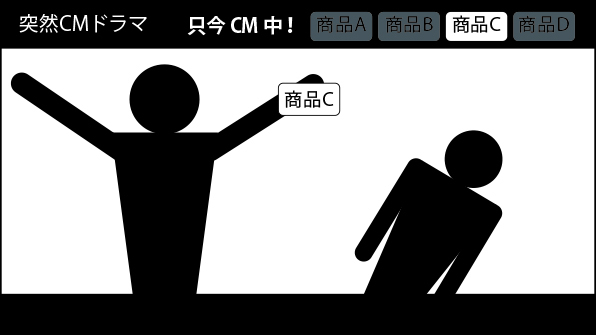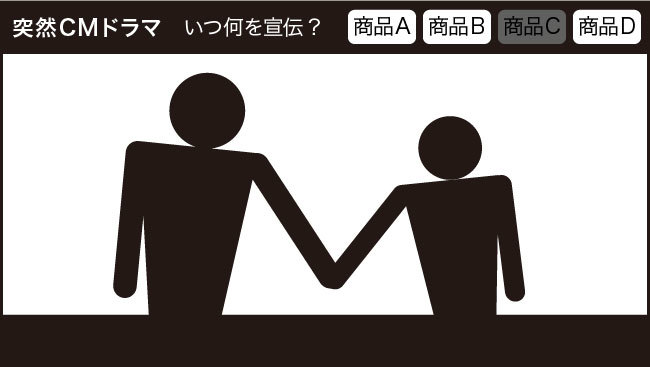Note: This website was automatically translated, so some terms or nuances may not be completely accurate.
ad-fusion ~Transforming the Future of Advertising and Television~
Starting this time, over two installments, we will discuss "ad-fusion," an advertising methodology developed by our Dentsu Inc. Ad-Fusion team.
In Part 1, I, Takanori Nakao, one of the creators of this mechanism, will explain what ad-fusion is. Part 2 will feature a conversation with Isao Kagari (P. Garita), the producer from Fuji TV who collaborated on the drama's planning and production, discussing the world's first ad-fusion drama, "Detective Kojin," which realized this technique in a TV drama.
Advertisements are tenants within the main content
Unfortunately, advertising is not the main content. If we define "main content" as "what the person intends to see," then advertising always exists by renting space and intruding upon that main content.
Signs intrude when you're trying to view scenery, newspaper ads intrude when you're trying to read an article, and TV commercials intrude when you're trying to watch a program. Questioning this fundamental premise – that "advertising is not the main content" – was the first step in developing the adfusion concept.
Why does advertising need to be interesting?
In presentations, we often hear descriptions like "It's interesting and impactful" or "It's unforgettably interesting once you see it." While this is certainly true and a valid point, there's actually a more fundamental reason: advertising absolutely must be interesting.
Ah, writing "interesting" might be misunderstood as meaning "making people laugh," so let's rephrase it as "creative." Not limited to humor, advertising bears the obligation to absolutely demonstrate creativity in various forms—be it beauty, excellence, surprise, or more. Why?
It's to earn permission.
To earn the audience's permission to borrow space from their main content, and to earn their permission to show ads during the precious time they've set aside for that main content. That's why ads are obligated to welcome people with the ultimate hospitality: creativity. At least, that's how I've always approached making ads.
Ads become the main content! That's Adfusion.
Adfusion overturns this fundamental principle that "ads exist by borrowing space from the main content."
The inspiration came from the movie "The Truman Show" starring Jim Carrey. The fictional show within the movie, "The Truman Show," broadcasts the life of one man as a program. The protagonist lives his life completely unaware that viewers worldwide are watching him.
Naturally, this fictional show had sponsors. That's why, while brushing his teeth in the morning, his wife would suddenly turn the toothpaste package toward the camera and deliver a full-blown advertising message. Seeing this mechanism that aimed to make the show and the ads seamless, I was shocked and simultaneously sensed enormous potential for the future of advertising.
The next turning point came when I worked on projects like "AKB48 Eguchi Manami" and "Otona AKB48" for my job. Both of these projects were full-blown advertising campaigns. Yet, the advertising campaigns themselves were meant to be enjoyed by the public – they were the main content. Yes, they weren't just piggybacking on some other main content; the advertising itself was the main content.
Then the decisive moment arrived: the dawn of an era where ads get automatically skipped. To overcome this serious situation—where TVs, PCs, and recorders automatically skip commercials—we needed
・Ads that can't be skipped
・Ads you can't wait to see
・Ads you deliberately want to watch
became absolutely essential.
And the concept that made this possible was turning ads into the main content—Adfusion. Main content = can't be skipped = eagerly awaited = deliberately watched.
It's different from seamless integration, different from product placement, different from tie-ins. Adfusion has only two rules:
So, how does adfusion make advertising the main content? It's remarkably simple. While conventional commercials are structurally separated from the main content, adfusion, as its name "ad" and "fusion" suggests, completely merges advertising with the main content. By achieving this complete fusion, the ad itself becomes the main content.
To understand adfusions, we studied various examples. We discovered that, besides The Truman Show, several other works attempted to seamlessly integrate advertising with programming.
However, all of these were attempts to minimize the sense of advertising being a tenant within the main content. They aimed to make the ads feel as seamless as possible with the main program, encouraging viewers to enjoy the ads naturally alongside the content—essentially trying to eliminate the seams. This differs from the concept of Adfusion, which completely merges advertising and main content, transforming the ad itself into part of the main content.
Product placement is a similar technique, but it involves integrating products or goods without disrupting the main content. This is actually the opposite of fusion, representing a concept of "complete separation and coexistence."
Recently, program tie-in commercials have gained prominence. This mechanism, seen in shows like "We Married as a Job!" and "Nobility Detective," features actors appearing in commercials while maintaining their drama roles. However, despite the shared setting, commercials and dramas are structurally broadcast as completely separate entities.





But if it's that integrated, isn't it just stealth marketing? If you're wondering that, rest assured. Adfusion is entirely different from stealth marketing. That's because stealth marketing pretends not to be advertising, blending into the main content to achieve advertising effects.
In contrast, Adfusion is designed to make people think, "Wow, they really wove the ad in there!" It only works because it's clearly identified as advertising. So, stealth marketing and Adfusion are fundamentally opposite in both mechanism and philosophy.
Thus, ad fusion aims for the complete integration of advertising and main content, differing from seamless integration, product placement, or tie-ups. Yet the rules for achieving this fusion are extremely simple, just two:
・Advertising must never detract from the inherent appeal of the main content itself
・Conversely, advertising must enhance the appeal of the main content
That's literally it. Well, I get the theory, but can you really pull that off? For those readers wondering, after about a year from conception, we finally made it happen!
The first commemorative installment of Ad Fusion in action: the world's first Ad Fusion drama, "Detective Kojiin"
This is "TV Ad Fusion," realizing the fusion of "TV programs" and "advertising" from among numerous main content types. Furthermore, while TV programs include variety shows, sports broadcasts, and more, this work is an Ad Fusion Drama that completely merges TV drama with advertising.
For the drama synopsis and cast comments, please see here.

Here's a brief explanation of how ad fusion works within the program.
・Before commercials

The screen clearly indicates that four commercials will air.
Viewers enjoy the drama while watching to see when and how the commercials will interrupt.
・During commercials

When the commercial begins, "Product C" changes to a specific brand name. The upper-left super also changes to "Commercial Now Airing," clearly indicating to viewers that an advertisement is playing.
Viewers enjoy the commercial as part of the drama, surprised by this approach: "Is this how you do commercials?!"
・After the commercial break

The display for Product C changes to indicate the commercial has ended. We continue enjoying the drama while also looking forward to when and how the remaining commercials will appear.
Through this mechanism, commercials are broadcast seamlessly woven into the drama itself. Moreover, the commercials aren't just integrated into the story; the products and their features become crucial clues to solving the case, offer glimpses into the protagonist's talents or personality, or even turn into unexpectedly vital items indispensable to the plot. They function as elements that make the mystery drama itself more interesting and deeper. This aspect is precisely the pinnacle of adfusion.
Creating New Advertising Value Beyond Reach
Regarding this ad-fusion drama "Detective Koji," I'll share more details in my next conversation with Fuji TV's Garita P, Mr. Akematsu.
Through TV ad fusion, programs evolve into "shows sponsors want to support more." And TV commercials evolve into "commercials you don't skip," "commercials you look forward to," and "commercials you absolutely want to see."
Simultaneously, what we anticipate is creating new value for commercials distinct from mere reach. When product information and features are presented as part of the main content viewers want to see, we predict they will be received with significantly higher favorability and understood much more deeply than if conveyed through a standard commercial.
It's also easy to foresee a dramatic drop in program abandonment rates during commercials. Discovering these new functions and effects of commercials beyond mere reach through measurement, and systematizing them as a menu, is another key objective of this drama ad fusion initiative.
The Dentsu Inc. Adfusion team will continue to develop this initiative further, realizing and deploying new forms of adfusion—such as variety show adfusion, movie adfusion, sports (live broadcast) adfusion, and game adfusion —to meet the changing times and sponsor needs. Stay tuned!!!
<Program Overview>
■Title: "Detective Kojin: Sudden Commercial Drama"
■Broadcast Date & Time: Wednesday, June 20, 2018, 12:30 AM - 1:30 AM on Fuji TV
*Available for free on FOD for one week immediately after broadcast
■Cast
Nobuaki Kaneko
Aimi Satsukawa
Kana Kita
Motoki Ochiai
Takashi Tsunoda
・
Rie Minemura
Masu Takeshi
■Storyteller
Kenichi Takito
■Staff
Concept & Overall Design: Takanori Nakao, Saburo Ito (Dentsu Inc.), Isao Akematsu (Fuji Television)
Producer: Takuya Seki (Kyodo Television)
Director/Producer: Yosuke Goto (Kyodo Television)
Screenplay: Hayashi Mori
Planning: Osamu Nozaki (Fuji Television)
Production & Copyright: Fuji Television
Production Cooperation: Kyodo Television
Was this article helpful?
Newsletter registration is here
We select and publish important news every day
For inquiries about this article
Author

Takatoshi Nakao
Dentsu Inc.
4CRP
Creative Director / Content Director / Communications Director
Born in Kyoto Prefecture. Major works include Suntory's Kadowari Sakaba Lemon Sour "Lemonzawa Tomio" series, Shueisha Weekly Shonen Jump's "Haikyuu!!" uniform project, Ezaki Glico Ice no Mi "AKB48 Eguchi Manami" and "Adult AKB48," Xcom Global's "Imoto's WiFi," and Sanoyas Shipbuilding's "Shipbuilding Boss Series." Recipient of numerous domestic and international awards including Cannes Lions, Spikes Asia, and ACC Awards.

